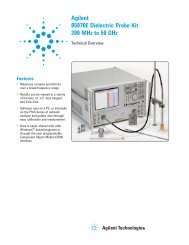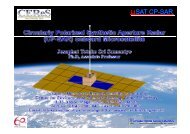You also want an ePaper? Increase the reach of your titles
YUMPU automatically turns print PDFs into web optimized ePapers that Google loves.
J.Oto.Ktrl.Inst (J.Auto.Ctrl.Inst) Vol 1 (2), 2009 ISSN : 2085-2517<br />
does not change with the amplitude of the current.<br />
The simulation used eight batteries as energy storage with the capacity was 36 Ah and the<br />
internal resistance of the batteries was 0.045 Ω.<br />
2.5 Regenerative Braking<br />
Regenerative braking is a mechanism to reduce the vehicle speed by converting some of its<br />
kinetic energy to other useful form of energy [27]-[29]. This converted energy can be used to<br />
charge the energy storage in the system, such as a battery or a capacitor. The regenerative<br />
braking is different from an auxiliary drive braking, where the electrical energy is dissipated<br />
as heat by passing current through large bank of variable resistors.<br />
The total energy dissipation is limited by either the capacity of the supply system to absorb<br />
this energy or by the SOC of the battery. If SOC of the battery is full, the auxiliary drive<br />
braking will absorb the excess energy. In order to capture the regenerative braking energy,<br />
the total traction torque must be negative.<br />
3 Load Profile of the Electric Drive Systems<br />
The load used in this paper was drive cycle of ICE karting at race day for one lap (48<br />
seconds). This drive cycle had previously been measured by the Flap track software at<br />
Göteborg karting ring track. The speed profile of the ICE karting for one lap can be seen in<br />
Figure 6. The drive shall be optimized for 10 minutes heat in full race and 3 minutes for in<br />
and out laps.<br />
Figure 6. Speed profile of ICE karting at Göteborg karting ring track<br />
According to this speed characteristic, the traction torque at the wheel is varying between 47<br />
Nm and -78 Nm. The negative torque indicates that the ICE karting is in deceleration or in<br />
regenerative braking region. It is clear that the regenerative braking or deceleration torque<br />
is higher than the acceleration torque. Therefore, the regenerative power used in charging<br />
the battery must be limited due to the limitation of the electric motor, power electronic<br />
converter and battery capability [27].<br />
4 Modeling of the Electric drive system<br />
The model of electric traction drive system for electric karting is implemented using<br />
14






